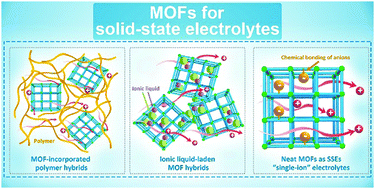Metal–organic frameworks for solid-state electrolytes
Abstract
Solid-state batteries with metallic anodes have attracted great attention due to their high energy density and safety. As an indispensable part of these batteries, solid-state electrolytes (SSEs) with excellent mechanical strength and non-flammability play a significant role in suppressing the growth of dendrites and eliminating the risk of short circuits, whose development could greatly promote the overall battery performance. Recently, metal–organic frameworks (MOFs), a type of porous crystalline inorganic–organic material, have shown potential for the fabrication of high-performance SSEs, which have become an emerging research direction. Benefiting from the rich porosity, controllable functionality and modularity, MOFs not only offer great opportunities for manipulating the physicochemical and electrochemical properties of SSEs, but also provide ideal platforms for investigating the underlying mechanisms of ion conduction and the structure–property relationships. In this perspective, the development of MOF-based SSEs, which include MOF-incorporated polymer hybrids, ionic liquid-laden MOF hybrids, and neat MOFs as SSEs, is outlined. By discussing the pioneering works, both the opportunities and challenges in each SSE category are presented. Additionally, some design principles for MOFs and MOF-based SSEs, as well as the future directions for further development are provided.



 Please wait while we load your content...
Please wait while we load your content...